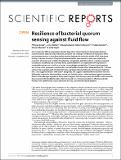Resilience of bacterial quorum sensing against fluid flow
Author(s)
Emge, Philippe; Moeller, Jens; Stocker, Roman; Vogel, Viola; Jang, Hongchul; Rusconi, Roberto; Yawata, Yutaka; ... Show more Show less
DownloadResilience of bacterial.pdf (954.4Kb)
PUBLISHER_CC
Publisher with Creative Commons License
Creative Commons Attribution
Terms of use
Metadata
Show full item recordAbstract
Quorum sensing (QS) is a population-density dependent chemical process that enables bacteria to communicate based on the production, secretion and sensing of small inducer molecules. While recombinant constructs have been widely used to decipher the molecular details of QS, how those findings translate to natural QS systems has remained an open question. Here, we compare the activation of natural and synthetic Pseudomonas aeruginosa LasI/R QS systems in bacteria exposed to quiescent conditions and controlled flows. Quantification of QS-dependent GFP expression in suspended cultures and in surface-attached microcolonies revealed that QS onset in both systems was similar under quiescent conditions but markedly differed under flow. Moderate flow (Pe > 25) was sufficient to suppress LasI/R QS recombinantly expressed in Escherichia coli, whereas only high flow (Pe > 102) suppressed QS in wild-type P. aeruginosa. We suggest that this difference stems from the differential production of extracellular matrix and that the matrix confers resilience against moderate flow to QS in wild-type organisms. These results suggest that the expression of a biofilm matrix extends the environmental conditions under which QS-based cell-cell communication is effective and that findings from synthetic QS circuits cannot be directly translated to natural systems.
Date issued
2016-09Department
Massachusetts Institute of Technology. Department of Civil and Environmental EngineeringJournal
Scientific Reports
Publisher
Nature Publishing Group
Citation
Emge, Philippe et al. “Resilience of Bacterial Quorum Sensing against Fluid Flow.” Scientific Reports 6.1 (2016): n. pag.
Version: Final published version
ISSN
2045-2322